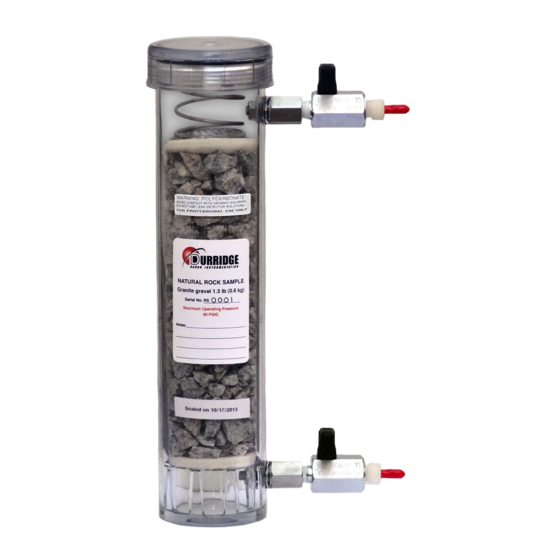DURRIDGE NATURAL ROCK SAMPLE Руководство пользователя - Страница 10
Просмотреть онлайн или скачать pdf Руководство пользователя для Измерительные приборы DURRIDGE NATURAL ROCK SAMPLE. DURRIDGE NATURAL ROCK SAMPLE 14 страниц. Performance monitoring accessory for the rad7

3 RAD7 THORON SENSITIVITY CHECK
3.1 Thoron Measurement
The RAD7 is capable of making a direct measurement of thoron gas concentration in air. It does this by
counting
Po decays inside its measurement chamber. However, Thoron has a short half life, 55.6s, so
216
most of the thoron in the sample will be lost during acquisition if the time from sampling to entering
the measurement chamber exceeds even a minute. Therefore when measuring thoron the sample
acquisition time must be as short as conveniently possible, and always consistent. Additionally, the
exact same setup should be used for thoron calibration as for thoron measurement. This setup
necessarily involves a specific length of tubing and a Small Drying Tube full of desiccant, as the RAD7
is less sensitive in a humid environment. Just as with radon, the Natural Rock Sample's thoron output is
a function of humidity at the rock-air interface, so it is important to ensure that your Natural Rock
Sample is thoroughly dried out before making a measurement.
The setup assumed in the RAD7 data processing and stated as standard in the manual consists of a
Small Drying Tube, which may be used as a wand for sniffing, along with a standard input tubing of 36"
(91.4cm) length and inner diameter of 3/16" (4.8mm), as shown below.
This typically gives the RAD7 a thoron sensitivity of about half its radon Sniff sensitivity. The
216
Po
daughter of thoron has only a 145mS half life so the main component in the response time of the RAD7
to a step change in thoron concentration is the time taken to acquire the sample. The response is
virtually instantaneous.
Figure 6 Thoron Measurement Standard Setup
3.1.1 Radon Interference
The alpha particle from
216
Po decay has an energy of 6.78 MeV, which is between the
218
Po and
214
Po
peaks in the
Rn decay chain. That places it within the B window of the RAD7 spectrum, while the
222
214
Po peak lies in the C window. About 1% of the
214
Po counts are in a low energy tail from the peak,
and spill into window B. The spill factor is measured during calibration and the count in window B is
corrected for that spill by the RAD7 and by DURRIDGE's CAPTURE software when calculating the
Sec$on 3
RAD7 Thoron Sensitivity Check
10
